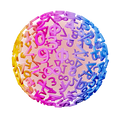How to Find the Scalar Product of Two Vectors (3D)
The scalar product or dot product is one of the most important mathematical operations related to vectors, most of all because it shows whether two vectors are perpendicular (° between them) to each other or not. When two vectors are perpendicular, they are said to be orthogonal. The rule looks like this:
Rule
Scalar Product and Orthogonality
Orthogonal vectors are vectors that are perpendicular to each other:
You have an equivalence arrow between the expressions. This means that if one of them is true, the other one is also true.
There are two formulas for finding the dot product (scalar product). One is for when you have two vectors on coordinate form, and the other is used when you know the length of the vectors and the angle between them.
Formula
Scalar Product for Vector Coordinates
Formula
Scalar Product when the Angle Is Given
Example 1
Decide whether the vectors and are orthogonal.
Example 2
Find the dot product of the vectors and with lengths and , when the angle between them is .
As the dot product is , you know that and are perpendicular, which is in line with the assumption that the angle between them is °.
Example 3
Find such that and are orthogonal.
For two vectors to be orthogonal, their dot product has to be .
When , the vectors are orthogonal. In that case, the vector is
Rule
The Angle Between Two Vectors
The angle between two vectors and is
Example 4
Find the angle between and .
You start by calculating the length of the two vectors:
Next, you find the dot product:
Finally, you can use this to find the angle, which is
Example 5
Let and , where and are two relatively unknown vectors. All you know is that , , and that the angle between and is . What is the angle between and ?
Like in Example 4, you start by finding the lengths of the two vectors. This time, you also have to use some rules when you are cleaning up dot products and parentheses, and especially that
Recall that . You get that
Next, you find the dot product in the same way:
You insert these values into the formula to find the cosine of the angle:
That finally gets you the angle, which is





















